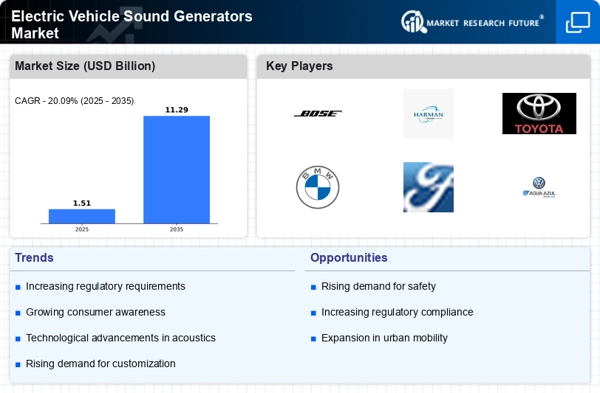Consumer Awareness and Preferences
Consumer awareness regarding the benefits of sound generators in electric vehicles is a significant driver for the Electric Vehicle Sound Generators Market. As more consumers become informed about the safety implications of silent vehicles, there is a growing preference for EVs equipped with sound generation technology. Surveys indicate that a substantial percentage of potential EV buyers prioritize safety features, including sound alerts for pedestrians. This shift in consumer preferences is likely to influence manufacturers to incorporate sound generators into their vehicle designs, thereby expanding the Electric Vehicle Sound Generators Market. The increasing focus on safety and awareness among consumers is expected to drive market growth as manufacturers respond to these evolving demands.
Increasing Demand for Electric Vehicles
The rising demand for electric vehicles (EVs) is a primary driver for the Electric Vehicle Sound Generators Market. As consumers increasingly opt for EVs due to environmental concerns and fuel efficiency, the need for sound generators becomes more pronounced. In 2025, it is estimated that the number of electric vehicles on the road will surpass 30 million units, leading to a corresponding increase in the demand for sound generation technology. This technology not only enhances safety by alerting pedestrians but also allows for customization, catering to consumer preferences. The Electric Vehicle Sound Generators Market is thus positioned to grow significantly as manufacturers seek to comply with regulations while meeting consumer expectations.
Regulatory Requirements for Sound Emission
Regulatory frameworks mandating sound emissions for electric vehicles are a crucial driver for the Electric Vehicle Sound Generators Market. Authorities in various regions have established guidelines that require EVs to emit sounds at low speeds to ensure pedestrian safety. For instance, regulations in several countries stipulate that electric vehicles must produce a minimum sound level when traveling under a certain speed threshold. This regulatory push is expected to drive the market, as manufacturers must integrate sound generators into their vehicle designs to comply with these laws. The Electric Vehicle Sound Generators Market is likely to see a surge in demand as automakers adapt to these evolving regulations, ensuring that their vehicles are both compliant and safe for urban environments.
Integration with Smart Vehicle Technologies
The integration of sound generators with smart vehicle technologies is emerging as a key driver for the Electric Vehicle Sound Generators Market. As vehicles become more connected and autonomous, the need for effective communication between the vehicle and its surroundings intensifies. Sound generators play a vital role in this communication, alerting pedestrians and other road users of the vehicle's presence. In 2025, the market for connected vehicle technologies is anticipated to grow significantly, further boosting the demand for sound generation systems. This integration not only enhances safety but also aligns with the broader trend of smart mobility solutions. The Electric Vehicle Sound Generators Market is thus likely to experience robust growth as manufacturers embrace these technological advancements.
Technological Innovations in Sound Generation
Technological advancements in sound generation technology are propelling the Electric Vehicle Sound Generators Market forward. Innovations such as the development of customizable sound profiles and integration with vehicle systems are enhancing the functionality of sound generators. In 2025, it is projected that the market for advanced sound generation systems will grow by over 15%, driven by consumer interest in personalized auditory experiences. These innovations not only improve safety but also allow manufacturers to differentiate their products in a competitive market. As technology continues to evolve, the Electric Vehicle Sound Generators Market is expected to benefit from increased investment in research and development, leading to more sophisticated sound generation solutions.


















Leave a Comment